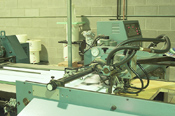
|
|
TPM Procedures

Manufacturing companies of every type of product and every size have had to face the significant costs that are inherent in maintenance. This has led to the development of procedures that will streamline and cut the costs (of both time and money), in the maintenance process. One of the leading processes is known as TPM or Total Productive Maintenance. While there are a number of plant maintenance processes that are employed by successful organizations, Total Productive Maintenance has moved to the forefront.
|
|
In any modern manufacturing facility the equipment that is used requires a level of maintenance, in order to ensure that the manufacturing process is not disrupted, and the production plan can be achieved. In some industries, (especially those using continuous production), the plant would have to shut down for annual maintenance, where equipment is repaired, and critical components replaced. World class companies spend considerable time and resources, on maintaining their equipment, as it is more effective to have a preventative maintenance plan, than repair or replace equipment, when it fails. This is where Total Productive Maintenance comes in. There are several subsets of maintenance that fall under this process. These are:
- Corrective Procedures-This type of maintenance procedure is used mostly in businesses that do not employ a preventative maintenance program. In its simplest form, a business will choose not to perform maintenance, on a piece of equipment until a failure occurs. When this failure happens (as it inevitably does),the plant maintenance department will then perform work on the item to either repair it, so that it can be placed back into service, or replace the piece of equipment, if it cannot be repaired, or requires maintenance, that would cause significant delays, to the production schedule.
- Preventive Maintenance-The businesses that use a preventative maintenance, will plan regular maintenance inspections, so that any issues that may occur with a piece of equipment, can be identified, before a critical failure occurs. Preventative maintenance also helps insure that critical parts, are replaced before they fail and consumable items, (such as oil and lubricants), are changed regularly.
- Predictive Procedures-There is some companies that use predictive maintenance to maintain their equipment. Predictive maintenance helps businesses to determine the condition of their equipment, so that they can predict when maintenance should be performed. While this may seem subjective studies show that this method can be a considerable cost saving, over preventive maintenance, as it allows maintenance departments to perform work on equipment only when they believe it is needed,rather than on a set schedule. This procedure is also known as condition-based maintenance, since a business can employ conditioning monitoring, which uses non-destructive testing, such as infrared, vibration analysis and sound analysis.
Which type of maintenance procedure that will be used depends on the industry, production processes, and size of the business. The type of plant maintenance used can also vary from year to year, depending on the needs and market of the company. However, one maintenance strategy, Total Productive Maintenance (TPM), has become increasingly popular.
TPM is a manufacturing led initiative that emphasizes the continuous improvement philosophy. It also focuses on the importance of production and maintenance staff working together. This has been brought about largely due to the fact that as customer satisfaction, becomes the primary differentiator, businesses are increasingly sensitive to meeting customer's delivery dates. Adhering to the production schedule becomes critically important, and maintenance of equipment, has become an integral part of the manufacturing process. By insuring production and maintenance staff will be working together, the business should find that equipment issues are reported earlier, and production delays are avoided.
The bottom line is that businesses that have introduced TPM have seen a number of benefits including but not limited to: a better understanding of the performance of their equipment, improved co-operation between manufacturing and plant maintenance staff, reduced maintenance costs and extended life of manufacturing equipment.
Privacy Policy, Terms of Use